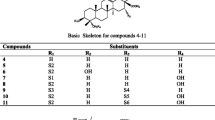Abstract
Antimicrobial activity of methanolic extracts obtained from the aerial parts of Evax pygmaea was tested against five bacteria and two strains of phytopathogenic fungi using the agar diffusion and broth microdilution methods. Antioxidant properties were evaluated through the ability of the different fractions to scavenge the stable ABTS (2,2′-azinobis-(3-ethylbenzothiazoline-6-sulfonic acid)) and DPPH (1,1-diphenyl-2-picrylhydrazyl) radicals. The TEAC (Trolox Equivalent Antioxidant Capacity) and IC50 values of the fractions were calculated and compared. The experimental data indicated that all fractions exhibit moderate to appreciable antibacterial activities against all Gram-positive cocci and Gram-negative rods except Pseudomonas aeruginosa, but no antifungal activity was observed. Ethyl acetate and methanol fractions were found to cause significant free radical-scavenging effects in both assays. These results may suggest that E. pygmaea could be used as a natural preservative ingredient in the food and/or pharmaceutical industries.




Similar content being viewed by others

References
Boukamcha H, Ben Jannet H, Chriaa J, Mighri Z (2004) Etude biologique et chimique de la plante Cardopatium amethystinum poussant en Tunisie. Structures de deux derivés benzaldehydiques. Identification de constituants de fractions apolaires par CPG/S.M. Journal de la Sociéte Algérienne de Chimie 14(1):65–78
Bruneton J (1993) Pharmacognosie, phytochimie, plantes médicinales, 2ème edn. Paris, p 519
Burt S (2004) Essential oils: their antibacterial properties and potential applications in foods a review. Int J Food Microbiol 94:223–253
Candan F, Unlu M, Tepe B, Daferera D, Polissiou M, Sökmen A, Akpulat HA (2003) Antioxidant and antimicrobial activity of the essential oil and methanol extracts of Achillea millefolium subsp. millefolium Afan. (Asteraceae). J Ethnopharmacol 87:215–220
Cornwell DG, Jones KH, Jiang Z, Lantry LE, Southwell Keely P, Kohar I, Thornton DE (1998) Cytotoxicity of tocopherols and their quinones in drug-sensitive and multidrug-resistant leukemia cells. Lipids 33:295–301
Cuendet M, Hostettmann K, Potterat O (1997) Iridoid glucosides with free radical-scavenging properties from Fagraea blumei. Helvetica Chimica Acta 80:1144–1152
Czinner E, Hagymasi K, Blazovics A, Kery A, Szoke E, Lemberkovics E (2000) In vitro antioxidant properties of Helichrysum arenarium (L.) Moench. J Ethnopharmacol 73:437–443
Ðordevic S, Petrovic S, Dobric S, Milenkovic M, Vucicevic D, Zizic S, Kukic J (2007) Antimicrobial, anti-inflammatory, anti-ulcer and antioxidant activities of Carlina acanthifolia root essential oil. J Ethnopharmacol 109(3):458–463
Ivanova D, Gerova D, Chervenkov T, Yankova T (2005) Polyphenols and antioxidant capacity of Bulgarian medicinal plants. J Ethnopharmacol 96:145–150
Kim KS, Lee S, Lee YS, Jung SH, Park Y, Shin KH, Kim BK (2003) Anti-oxidant activities of the extracts from the herbs of Artemisia apiacea. J Ethnopharmacol 85:69–72
Marmonier AA (1987) Bactériologie médicale. Techniques usuelles. Chap. 4. Antibiotiques, Technique de diffusion en gélose méthode des disques. ©SIMEP SA-PARIS, France, pp 238–244
Miliauskas G, Venskutonis PR, van Beek TA (2004) Screening of radical-scavenging activity of some medicinal and aromatic plant extracts. Food Chem 85:231–237
Oueslati MH, Ben Jannet H, Abreu PJM, Mighri Z (2004) Alcohols tetrahydropyraniques antintibatériens de la plante Rhantherium suaveolens poussant dans le sud tunisien. Journal de la Sociéte Algérienne de Chimie 14(2):245–258
Piao XL, Park IH, Baek SH, Kim HY, Park MK, Park JH (2004) Antioxidative activity of furocoumarins isolated from Angelicae dahuricae. J Ethnopharmacol 93:241–246
Pietta PG (2000) Flavonoids as antioxidants. J Nat Prod 63:1035–1042
Pike J, Chandra RK (1995) Effect of vitamin and trace element supplementation on immune indices in healthy elderly. Int J Vitam Nutr Res 65:117–120
Pottier-Alapetite G (1981) Flore de la Tunisie. Angiospermes-Dicotylédones Gamopétales. Publication Scientifiques Tunisiennes, p 1070
Re R, Pellegrini N, Proteggente A, Pannala A, Yang M, Rice-Evans C (1999) Antioxidant activity applying an improved ABTS radical cation decolorization assay. Free Radic Biol 26:1231–1237
Ronda LA, Rybak MJ (2001) Bactericidal activities of two daptomycin regimens against clinical strains of glycopeptide intermediate-resistant Staphylococcus aureus, vancomycinresistant Enterococcus faecium and methicillin-resistant Staphylococcus aureus isolates in an in vitro pharmacodynamic model with simulated endocardial vegetations. Antimicrob Agents Chemother 45(2):454–459
Scalbert A (1991) Antimicrobial properties of tannins. Phytochemisrry 30(12):3875–3883
Soliman KM, Badeaa RI (2002) Effect of oil extracted from some medicinal plants on different mycotoxigenic fungi. Food Chem Toxicol 40:1669–1675
Tepe B, Sokmen M, Akpulat AH, Sokmen A (2005) In vitro antioxidant activities of the methanol extracts of four Helichrysum species from Turkey. Food Chem 90:685–689
Tiwari OP, Tripathi YB (2007) Antioxidant properties of different fractions of Vitex negundo Linn. Food Chem 100:1170–1176
Torres R, Faini F, Modak B, Urbina F, Labbe C, Guerrero J (2006) Antioxidant activity of coumarins and flavonols from the resinous exudate of Haplopappus multifolius. Phytochemistry 67:984–987
Tsuchia H, Sato M, Miyazaki T, Fujiwara S, Tanigaki S, Ohyama M, Tanaka T, Lumina M (1996) Comparative study on the antibacterial activity of phytochemical flavanones against methicillin-resistant Staphylococcus aureus. J Ethnopharmacol 50:27–34
Acknowledgements
The authors are grateful to Dr. Fethia Harzallah Skhiri (High School of Horticulture and Animal Production. Chott Mariem, Sousse, Tunisia) for the botanical identification, Pr. Amina Bakhrouf (Laboratory of Environment Microbiology, Faculty of Pharmacy, Monastir, Tunisia) for her patient assistance in antibacterial assays and Dr Mejda Daami (Laboratory of Phytopathology, Regional pole of research-development agriculture, Chott Mariem, Sousse, Tunisia) for assistance in antifungal assays.
Author information
Authors and Affiliations
Corresponding author
Rights and permissions
About this article
Cite this article
Boussaada, O., Chriaa, J., Nabli, R. et al. Antimicrobial and antioxidant activities of methanol extracts of Evax pygmaea (Asteraceae) growing wild in Tunisia. World J Microbiol Biotechnol 24, 1289–1296 (2008). https://doi.org/10.1007/s11274-007-9600-7
Received:
Accepted:
Published:
Issue Date:
DOI: https://doi.org/10.1007/s11274-007-9600-7



